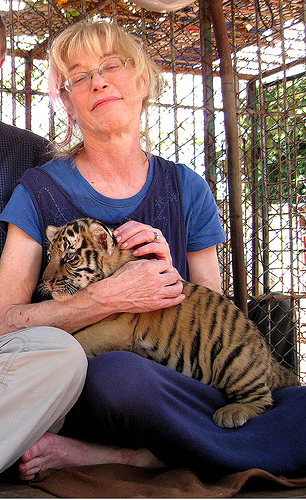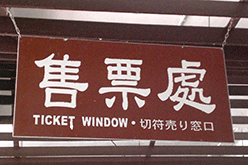141. The "Tiger" Radical: 虍
There are two ever-so-slightly confusing things about the "tiger" radical:
虍 (コ: "tiger" radical; mottled; tiger spots)
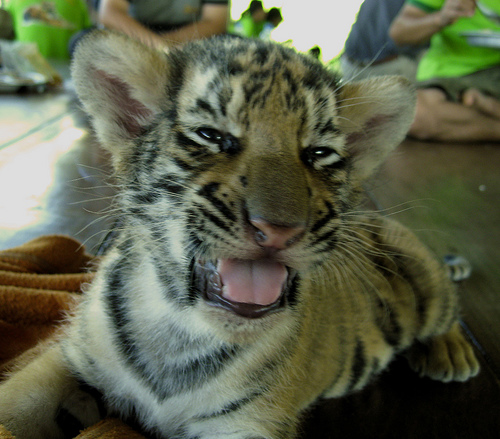
All tiger photos courtesy of Susan Stevens
Confusing Nomenclature
For starters, the radical is called とら, とらかんむり, or とらがしら (at least, according to some sources). The とら in these names made me expect that とら would be the yomi of 虍. That would make perfect sense because とら means "tiger." But ... no! The non-Joyo kanji 虍 only has the on-yomi of コ. So does the following kanji, which is the real とら:
虎 (2005: コ, とら: tiger, drunkard)
Let's turn to the second area of confusion. In とらかんむり and とらがしら, the suffixes -かんむり and -がしら refer to the positions of the radical in the characters—but inaccurately so. The first suffix, -かんむり (冠), means "crown." A "crown" radical perches atop a kanji, just as the "grass" radical 艹 does in 芝 (1335: lawn grass). However, the 虍 radical actually encloses characters by running across the top and down the left side, just as classic enclosing radicals such as 匚, 厂, and ⻌ hem a character in on at least two sides.
The other position suffix, -がしら, is a kun-yomi of 頭 (head). When it comes to the positions of kanji radicals, "head" is just like "crown" (e.g., Jack fell down and bumped his crown), so -かんむり and -がしら turn out to be equally misleading.
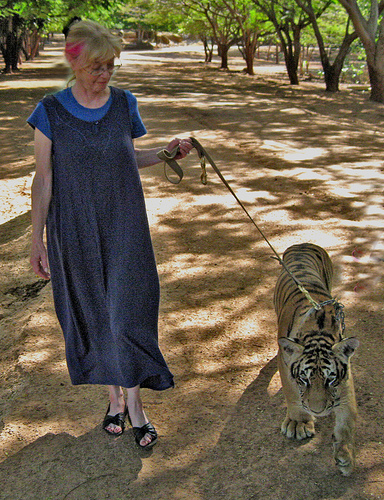
The "Tiger" Kanji and Its "Tiger" Radical
With all that cleared up, let's return to the "tiger" kanji:
虎 (2005: コ, とら: tiger, drunkard)
Not surprisingly, the radical here is 虍. The "tiger" radical 虍 and the "tiger" kanji 虎 are easy to mix up, but note that the "tiger" kanji has 儿. As you'll see below, this 儿 component represents "torso and legs." If he's a drunkard, as indicated, I suppose the legs are unsteady!
This kanji, which is a non-Joyo kokuji (a character invented in Japan, as explained in the glossary), features our "tiger" radical. The kanji can represent a killer whale, which really exists, or a mythical type of fish. You'll see this character at the core of the following word:
金鯱 (きんのしゃちほこ or きんしゃち: golden dolphin)
In fact, this imaginary animal bears no resemblance to a dolphin. As I describe in essay 1973 on 瓦 (roof tile), it has the body of a fish, the head of a tiger, and a menacing tail held high.
The above sign appears in Nagoya Castle, which is famous for having had a "golden dolphin" on its roof. Here's the statue in question:
Photo Credits: Eve Kushner
Do you see a tiger anywhere? If anything, I see a fierce pineapple!
The "Tiger" Radical in Other Joyo Kanji
The 虍 shape also serves as the radical in four more Joyo kanji:
虞 (1040: fear, anxiety, concern, uneasiness; danger, risk, adverse chance)
虐 (1147: to oppress, tyrannize)
虚 (1156: void, vacant; false, falsehood; futile)
虜 (1903: captive)
All of these definitions have extremely negative meanings! I guess it doesn't pay to tangle with tigers.
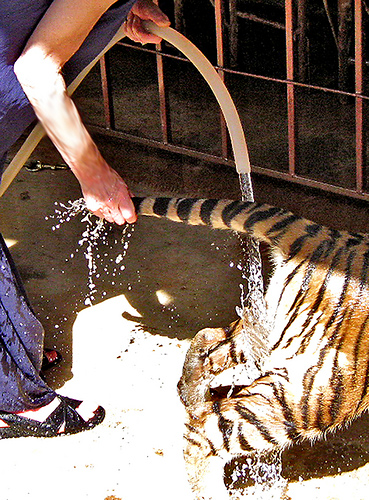
In another four Joyo characters, 虍 is a mere component, but it continues to occupy the "enclosing" position in each one:
劇 (848: drama, intense)
戯 (1138: to frolic)
膚 (1757: skin)
慮 (1904: consideration)
Inside most of these nine "tiger pens," I see many autonomous kanji (such as 呉 and 思), so I'm curious to know what accompanies each tiger. Let's look at Henshall's etymologies of these characters. Before we do that, though, let's examine the origins of 虍 itself.
The Etymology of the "Tiger" Radical
Sears says it represents the "head of a tiger pointing left." I could have sworn that it's pointing right, and it doesn't look too tigerlike to me, but never mind! This is how 虍 looked in the earliest years, all courtesy of Richard Sears:
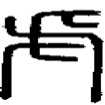
Seal-style character.
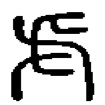
LST seal–style character.
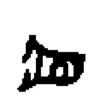
Oracle character.
This last one resembles a crocodile's mouth ... or a horse ... or ... It's a bit of a Rorschach test, isn't it?!
Etymologies of Joyo Kanji with the On-Duty "Tiger" Radical
Now that we know about 虍, perhaps we can understand 虎 a bit better:
虎 (2005: drunkard, tiger)
This is a pictograph of a "tiger." According to Kanjigen, the 虍 here symbolizes the "head," whereas 儿 is the "torso and legs." This 儿 evolved from a different shape than the component 儿 (which often means "human legs"), so the meaning here isn't the same as usual.
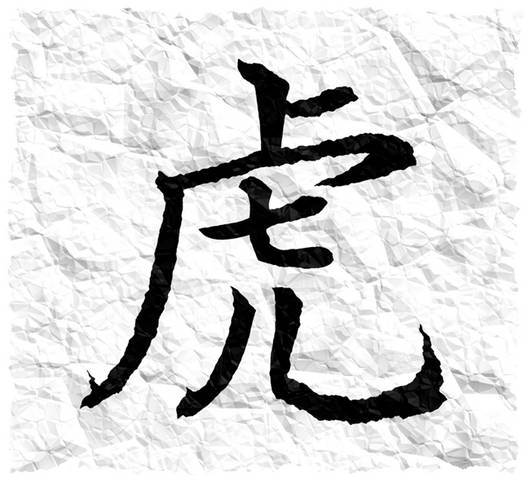
Here are Henshall's etymologies for the remaining four in the radical category:
虞 (1040: fear, anxiety, concern, uneasiness; danger, risk, adverse chance)
Originally, this character represented a mythical, tigerlike creature that had black spots and stood against a white background! How specific! The 呉 part acted phonetically to express "(color) contrast" and possibly to convey the sense of "unproven fact." Since those olden days, though, people have confused 虞 with 慮 (1904), so 虞 has come to mean "fear." Instead of a cowardly lion, we have a fearful tiger!
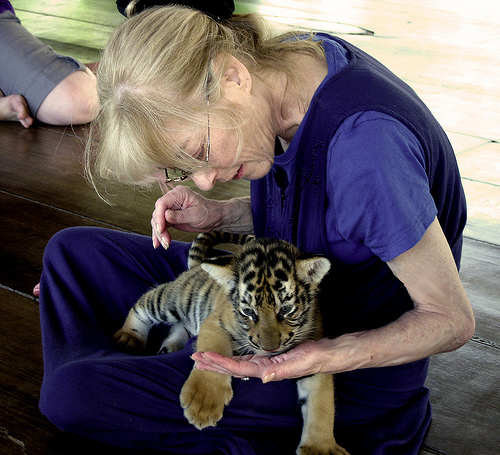
虐 (1147: to oppress, tyrannize)
The original shape showed a "tiger clawing (E) a person." The person has now disappeared from the pictograph. I would, too, if I were being clawed!
虚 (1156: void, vacant; false, falsehood; futile)
According to Henshall in his newer edition, the ancient shape contained a variation on 丘 (hillock) + 虍 (tiger). In addition to being the “tiger” radical, this 虍 phonetically expressed “big,” so 虚 once meant “big hill.” One researcher sees the 丘-like shape as representing hillocks surrounding a depression or basin, but another scholar treats “empty” as loan usage, says Henshall.
虜 (1903: captive)
The man is not what he seems. That is, 男 is not "man" here but rather a combination of 力 (74: strength) and the topmost part of 貫 (1102: to pierce). In 虜, the 男 shape means "to gather strength" or "to muster strength." Even though 虍 is the radical and probably lends connotations of "tiger," it also acts phonetically to express "seize." Together, these parts originally meant "to seize something by mustering one's strength." Later, 虜 came to mean "seize" more broadly.
Etymologies of Joyo Kanji with the "Tiger" Component
Now for Henshall's etymologies of the characters in which 虍 is just a component:
劇 (848: drama, intense)
Some scholars feel that this character means "to attack with a sword (刂) in the manner of a tiger attacking a pig or wild boar (豕)." Supposedly, "intense" is an extended meaning, and "drama" is a borrowed meaning.
戯 (1138: to frolic)
In this character, we see 虚 (1156). We discussed 虚 above, but none of its meanings apply here. That's because 1138 originally had a very different shape—namely, 戲, which featured a "bean" (豆) under the "tiger" (虍) instead of a "hill." In 1138, the 虚 acts phonetically, expressing "to play" and possibly lending the meaning of "not in earnest." Meanwhile, 戈 means "halberd," a type of sword. Putting it together, we have "halberd used in play," rather than in earnest. That led to the more general meaning of "to play."
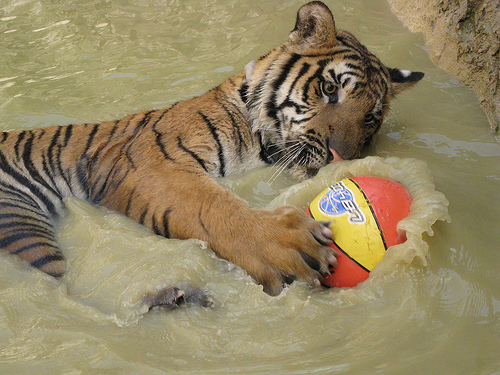
膚 (1757: skin)
This certainly looks like the belly (424: 胃) of a tiger, but that's not right. Henshall says in his newer edition that 膚 is the variant of the non-Joyo 臚. The 虍 in the 盧 phonetically conveys “bend, round, concave.” He offers nothing more about why 盧 contains a tiger but notes that in some versions of the shape that part represents an “inverted container” (and isn’t 虍, I suppose).
慮 (1904: consideration)
Whereas the 思 means "to think," just as you would think, the tiger doesn't behave at all like a tiger in this kanji. Rather, that shape acts phonetically, expressing "to count, calculate." Overall, the original meaning would be "consider and count," says Henshall in his newer edition. He also presents the idea that 慮 breaks down as 心 (heart, mind) + the remainder, which is a phonetic that means "urn, earthen jar" but that functions here to convey "set out in words, relate." If so, the whole character means "ponder extensively." Actually, that's a good story, too (though it lacks a tiger)!
Too bad none of these characters links "eye" (目) with "tiger"! Nor is there a single instance of "tiger" and "woods" (林)!
